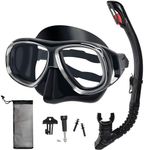Buying Guide for the Best Prescription Snorkel Mask
Choosing a prescription snorkel mask is all about making sure you can see clearly and comfortably underwater, just like you do with your regular glasses. The right mask will let you enjoy the beauty of the underwater world without worrying about blurry vision or discomfort. When shopping, focus on how well the mask fits your face, the type of prescription lenses it supports, and how easy it is to use and maintain. Understanding the key features will help you find a mask that matches your vision needs and snorkeling style.Prescription Lens TypePrescription lens type refers to how the corrective lenses are built into the mask. Some masks use pre-made lenses with set strengths, while others allow for custom lenses that match your exact prescription. Pre-made lenses are usually available in steps (like -1.0, -1.5, etc.), which can be a good fit if your prescription is simple and close to these values. Custom lenses are made to order and are best if you have a more complex prescription, including astigmatism or different strengths in each eye. To pick the right one, consider how closely your prescription matches the available pre-made options or if you need the precision of custom lenses.
Mask Fit and SealMask fit and seal is about how well the mask sits on your face and keeps water out. A good fit is crucial for comfort and to prevent leaks. Masks come in different shapes and sizes, so it's important to try them on if possible or check sizing guides. A mask that fits well will create a gentle suction when you press it to your face and inhale through your nose. If you have a smaller or larger face, or features like a high bridge or facial hair, look for masks designed for those needs. The right fit will make your snorkeling experience much more enjoyable.
Lens MaterialLens material refers to what the mask's viewing window is made from. Most quality snorkel masks use tempered glass, which is strong, scratch-resistant, and safe if it breaks. Some cheaper masks use plastic, which is lighter but can scratch more easily and may not be as clear. If you want the best clarity and durability, go for tempered glass. If you’re only snorkeling occasionally and want something lightweight, plastic might be enough. Think about how often you’ll use the mask and how important clear vision is to you.
Field of ViewField of view is how much you can see through the mask. Masks with a wide field of view let you see more of the underwater world without turning your head. This is usually affected by the shape and size of the lenses and the frame. If you want to enjoy panoramic views or spot more sea life, look for a mask with a wide, open design. If you prefer a smaller, more compact mask, you might have a slightly narrower view but a lighter feel. Choose based on how immersive you want your snorkeling experience to be.
Ease of Lens ReplacementEase of lens replacement is about how simple it is to change or upgrade the prescription lenses in your mask. Some masks are designed so you can swap out lenses yourself, which is handy if your prescription changes. Others require a professional or are not meant to be changed at all. If you expect your vision to change or want flexibility, look for a mask with user-replaceable lenses. If your prescription is stable, this may be less important.
Strap and Skirt ComfortStrap and skirt comfort refers to the parts of the mask that touch your face and hold it in place. The skirt is usually made of silicone or rubber, and a soft, flexible skirt will create a better seal and feel more comfortable. The strap should be easy to adjust and not pull your hair or pinch your skin. If you plan to snorkel for long periods, prioritize a mask with a soft skirt and a comfortable, adjustable strap to avoid discomfort or pressure marks.












